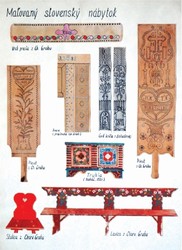Agáta Petrakovičová
Heřman Landsfeld was born in 1899 in Malenovice, a small Moravian town near Zlín. Young Heřman loved drawing very much. He was discovered at a local school by the well-known academic painter Marie Vořechová Vejvodová. She took him from Moravia to Slovakia in 1913 to the workshop of the Slovak Ceramics in Modra. After the rise of the first Czechoslovak Republic, good golden days flourished for the Slovak Ceramics in Modra. The painter of folk pottery Heřman Landsfeld was charged with making a new design book for the needs of painters. He worked on it for nearly five years. It represented a great variety of types, patters and decorative design of the Modra pitcher ware counting 259 drawings.
By that time Landsfeld was already turning into an enthusiastic collector. He would collect anything that related to pottery and pitcher-making craft. That was the beginning of one of the largest collections in Slovakia and Bohemia. Landsfeld collected ceramics, manufacturing tools, documents and colloquial terms and potters’ and pitcher-makers’ manuscripts. After leaving Modra he returned to Moravian Strážnice, in 1939, and turned his collection into a private museum. Fragments of the collection are now found in a number of museum depositories.
The efforts to acquire knowledge and new pieces for this collection brought Landsfeld to the idea of trying his hand at archeological work in old Haban (Hutterite) courtyards. In 1934 he decided to excavate at the site of a Haban courtyard at Košolná where he discovered the foundations of an Anabaptist workshop with valuable remains dating from the 17th century. He had completely given himself up to the passion of archaeology and excavated in other Haban ceramics centres as well.
Heřman Landsfeld devoted to private collecting along with his work of a ceramic painter in which he achieved great mastery. As early as 1919, he became the leading figure of the painter’s workshop in Modra.
As a painter, he and his wife-to-be Alžbeta Gajdová, contributed to the illustration of the ethnographic book by Antonín Václavík Podunajská dedina (The Danube River Valley Village. They documented the details of houses, facades, furniture, wine presses and folk costumes. From the illustrator’s work of Heřman Landsfeld another collecting passion came to be developed, namely his documentation of Slovak wooden, stone and iron tomb crosses. He also collected pipes. Today the collection is the property of the National Institute of Folk Culture at Strážnice. Another unique collection features butter churns of various shapes and design. Landsfeld strived to record also all the details of a traditional way of life of winegrowers in Modra. He devoted much attention to folk literature as well. We are able to reconstruct the life of Slovak and Moravian potters and pitcher makers thanks to the material gathered by Landsfeld.
